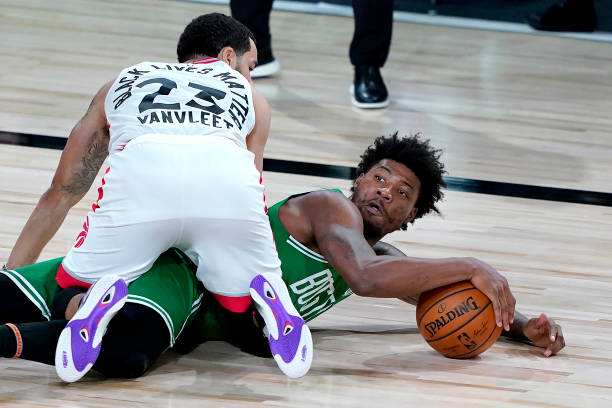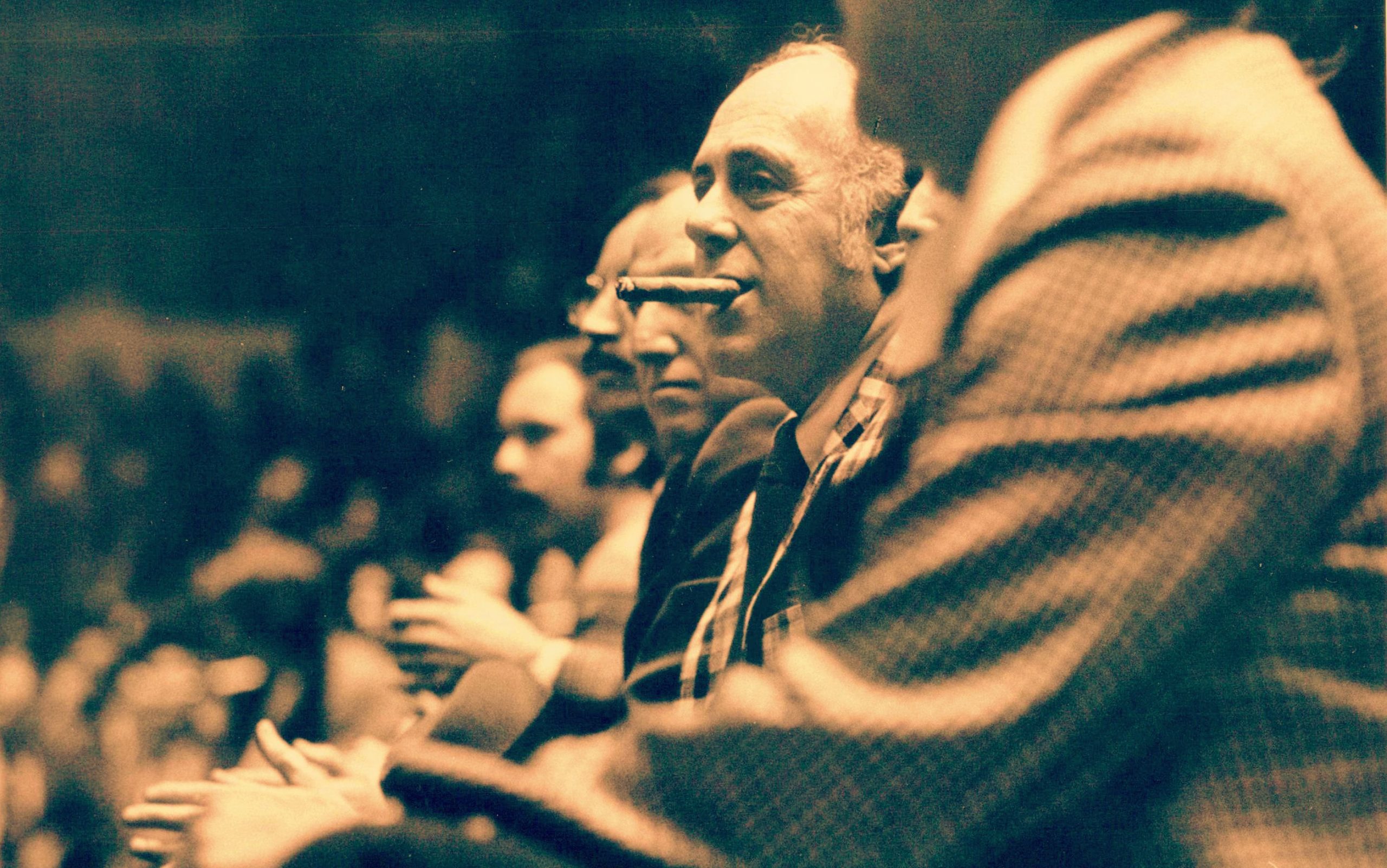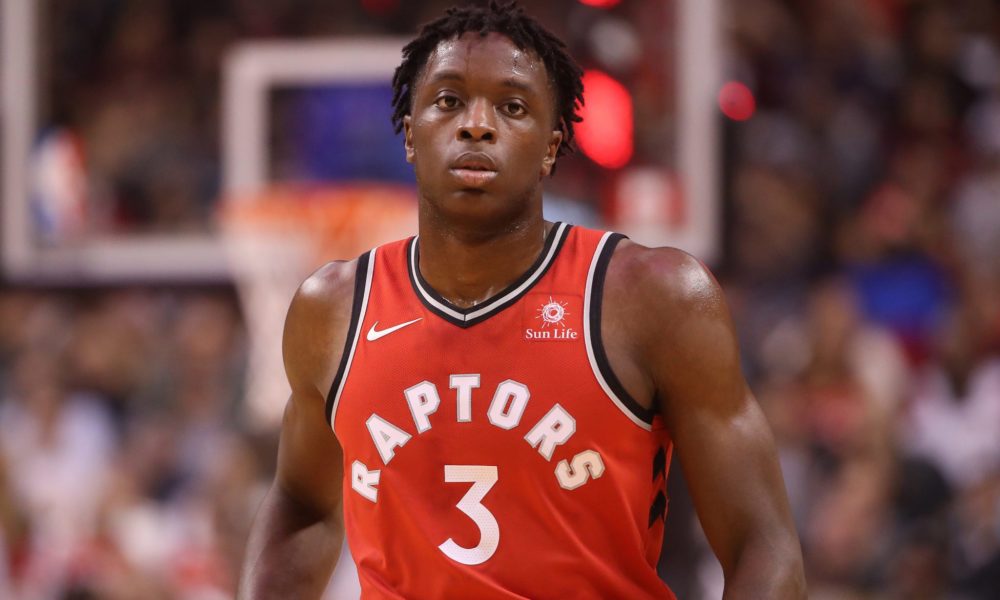Late in the fourth quarter of Toronto’s joyless loss to the Boston Celtics, Pascal Siakam found himself in the post. It wasn’t an uncommon thing, as far as the game went. He spent a lot of time in the post, scoring with a few gorgeous power moves through Marcus Smart and Jaylen Brown, and leaving some easy ones on the rim, too. Though Siakam played a subpar game, scoring 13 points and shooting 5-of-16 from the field, he was solid in the post. And in the fourth, he put Ojeleye on his back, took a few probing dribbles with his right, and eventually spun onto his left hand and lofted the ball up, earning free throws. As Ojeleye is immensely strong, Siakam went flying to the floor after the whistle. But even faster than he fell, Siakam’s teammates — Terence Davis, Chris Boucher, Norman Powell, and OG Anunoby — flew to lift him from the court.
It showed the level of trust that Toronto’s players hold in one another. Siakam had a rough outing, but his teammates were still there to pick up up, dust him off, and send him to the free throw line. That continued cohesion was a rare bright spot. But there are plenty of areas where the Raptors can be better. Here’s the blueprint to Toronto winning again.
Play defense like the Raptors again
The Raptors’ defense has been their most consistent contributor all year. They swarm and hawk and rotate and somehow don’t make any mistakes during all the chaos. That simply wasn’t the case against Boston.
At times, various Raptors committed ghastly errors. Siakam allowed a blow-by on one possession and then failed to tag the roller from the weak-side on the next; both plays resulted in uncontested Boston shots at the rim.
There were other, worse errors. Marc Gasol over-helped at times, under-helped at others, and frequently failed to impact the game from the defensive end.
Watch that play again, if you can take the punishment. Gasol was late to the height of the pick-and-roll, so he awkwardly closed the gap with his feet close together, shuffling towards the screen. His weight and gait gave away his obvious intent, and so Kemba Walker rejected the screen, heading away from Gasol, and leaving him in no-man’s land. Gasol didn’t fight or hustle to return to the play, though, so he spent three full seconds — a lifetime on the defensive end — as the player furthest from the hoop he was ostensibly defending. To further the madness, Gasol failed to stay with Walker when the guard jetted back to the perimeter, allowing Walker to find a wide-open catch-and-shoot triple to beat the buzzer.
If any fix involves Gasol and Siakam being better, it ought to happen naturally; both are typically wonderful and heady defenders. There were positive elements, besides. Fred VanVleet was, as expected, brilliant. He ripped six steals in the game, many by simply taking the ball from Boston’s ball-handlers. His defensive intensity was apparent. OG Anunoby was similarly engaged. But a team’s defense is, for the most part, only as good as its weakest link. And with Siakam and Gasol committing inexplicable and inexcusable mistakes, VanVleet and Anunoby couldn’t always cover for them. Boston found easy shots for the entire first quarter of the game, scoring 39 points. The Raptors tightened the screws going forward, so it wasn’t just the defense that killed them. But it was a huge ingredient in Toronto’s cocktail of misery from game one.
For much of the game, Boston found good looks without too much trouble. Toronto had to work much harder to create good shots. That’s a key reason why the Raptors faltered whenever they seemed on the verge of making a comeback run.
Use created advantages
The defense wasn’t Toronto’s only failing. Toronto also struggled to score the ball with any consistency. The basic stats are clear enough without diving too deep into the numbers: Toronto only managed 94 points on 36.9 percent shooting from the field and 25.0 percent shooting from deep. Toronto’s 30 missed triples set a playoff franchise record. But were the shots good?
It’s hard to parse poor input from poor output. Put another way, it’s hard to decipher when a basketball team is doing a poor job creating good looks or is simply doing a poor job at hitting fine looks. To that end, Toronto’s shots weren’t all terrible. Many of the team’s triples were good, in-the-flow-of-the-offense shots. VanVleet was bothered by flying limbs on a few of his 11 attempted triples, but a number of his misses were just that: misses. That happens, and it doesn’t point towards something that needs changing going forward. But at other times in game one, Toronto failed to create anything in the half-court. And when Toronto was held to only seven fast-break points, it’s even more imperative that the team always be able to create something good in the half-court. Boston could, and Toronto needs to match that going forward.
The thing is, it’s not that Toronto was without advantages. Instead, they failed to cascade those advantages into good shots.
VanVleet created an advantage in that play. At the time of his catch, he had two Celtics leaning towards him, trying to take away the deadly threat of his catch-and-shoot jumper. VanVleet did the correct thing: drive forward when your opponents’ weight is in the opposite direction. So far so good, but VanVleet already made a few errors by the second or third dribble of his drive. His head was down, not seeing the open Gasol kitty corner opposite him on the pop. He also didn’t see an open Anunoby in the strong corner when Anunoby’s defender cheated into the late to help. No, VanVleet fumbled but kept the ball, didn’t make any decision, and let the Celtics recover by allowing Theis defend him in space. He couldn’t create any openings and eventually threw the ball away trying to draw a foul. Quick decisions in the middle of the floor, spraying the ball to shooters, could open gaps in Boston’s defense.
At other times, VanVleet couldn’t capitalize on the advantages created by other players.
There Siakam twice created advantages — in the post, no less! — by drawing multiple defenders. That should lead to a good look for Toronto. Instead VanVleet forced a pass into traffic instead of taking the easy option. Serge Ibaka was open on the wing when the defense collapsed. Ibaka was one of Toronto’s lone bright spots, scoring a team-high 15 points and shooting three-of-seven from deep. VanVleet should have made a quicker read and hit Ibaka with an early-beat pass off the dribble. Instead Siakam’s good work yielded nothing better than a turnover. The Raptors need to thresh space out of the created holes in Boston’s defense.
Boston’s defense already showed a big gap: they allow VanVleet to attack a big alone in space in the middle of the floor. Against a lot of guards, that’s certain death. And at times, VanVleet made good decisions in those moments.
That miss was encouraging. Boston is letting VanVleet work in the middle of the floor, and he should be able to create some points out of that. Boston is conceding something, and if Toronto can’t turn that concession into an advantage, and then push that advantage in other ways, then the Raptors are simply letting their defenders win. VanVleet’s mid-range miss was a good example of good process bad outcome. More going forward would be welcome.
At other times, the Raptors were hesitant to shoot when good processes actually created good looks.
In that play, VanVleet and Lowry both passed up good looks from behind the arc. Sure, they combined to shoot 3-of-16 from deep in game one. That’s an ugly number. But Boston’s defense is too good for an opposing offense to turn down a good shot. VanVleet took 11 triples, and he could have taken more. Boston allows openings behind the arc, and Toronto needs to expose them. If Toronto ignores good shots, the result will usually be a bad one, or worse, a turnover. The Raptors committed six in the first eight minutes of the game. Taking the first good shot may not be as aesthetically pleasing as the Spurs-ian ideal of high assist rates and pretty team-wide passing plays, but taking the first good shot could be a good way for Toronto to put less work in for more consistent results.
Get up at the rim
Boston may not be a traditional team with massive size at the center position, but holy moly can these guys can still protect a rim. The Celtics are full of players who hunt the ball from behind, including Daniel Theis, Robert Williams, and others. When various Raptors tried to create layups without protecting the ball, or without a good vertical attack, it ended poorly. VanVleet and Siakam were both victims of gory blocks when they tried to caress the ball off the backboard from a distance. The Celtics won’t let you get away with that.
The Raptors need to find which players can create for themselves at the rim and finish there, and they need to put those players on the court and keep them there.
Powell is one such guy. He’s got impressive and speedy bounce, and it will be a rare trailing defender indeed who can beat that shot to the backboard. When Boston treated Powell like VanVleet, letting a big defend him in space, Powell chopped his strides, picked up his dribble, and leaped at the rim like a high-jumper. It worked. VanVleet may not have the vertical bounce to accomplish such feats, but he’s got to learn other ways to hurt Boston’s defense. Floaters are one way. But Powell showed the most direct possible route to payload. If the Raptors struggle, playing Powell 40 minutes a game could be one way to loosen the restrictions on the offense.
At other times, Toronto showed the value of bounce in less direct ways. Siakam has the bounce of Powell at the rim with much more length. He commands defensive attention. When he romped into the lane, Boston was loath to allow one big to defend in space. Instead, the Celtics sent plenty of help. Siakam didn’t do it often, but when he hit the paint on the move, good things usually happened.
Bouncy finishers are needed for Toronto. If not for themselves, then to open up the game for others, like VanVleet. His offensive performance in game one was maddening, and he finished a team-low minus-28 in the plus-minus column. He shot 3-of-16 from the field. Toronto could move him off the ball and let Powell or others create more, or Toronto could ask VanVleet to pass earlier from the middle of the floor, or they could ask him to score from the mid-range. There are a variety of ways that VanVleet can be better, and there other ways that Toronto can improve the areas in which VanVleet operates.
Not making bush league mistakes on defense is one obvious fix, outside of VanVleet’s offensive struggles, and you can bet that Toronto will find that. This game was an outlier, there. The other necessary improvements are more subtle. Toronto needs to create and use advantages better. Putting bouncy finishers into the game is one way to do that. So, too, can Toronto take the first good look the offense creates. Of course there are other ways to improve, and hitting a few triples would go much of the way towards soothing any difficulties. But that’s an output problem. For Toronto to be competitive, they need to fix the inputs that inform those triples in the first place.
The Raptors already possess one of the most important ingredients. These players trust one another. They aren’t going to change how they play because one or another player isn’t hitting his shots. They won’t turn on each another. When Siakam left the court a few minutes after being helped off the ground by four teammates, every other teammate on the bench jumped up to offer him high-fives. Within the span of a few possessions, virtually ever player on the Raptors had offered Siakam positive, physical encouragement, despite, or perhaps because of, his lackluster game. The Raptors won’t cave from the inside out. And if Coach of the Year Nick Nurse solves the tactical stuff, it’s easy to see how the Raptors can right the ship and make this into a competitive series.



